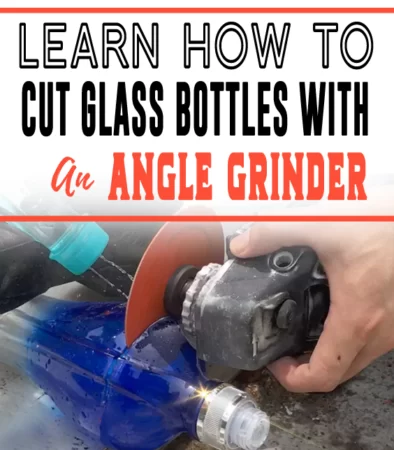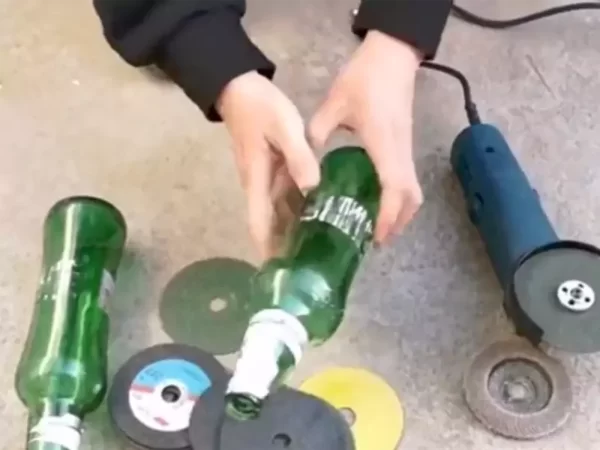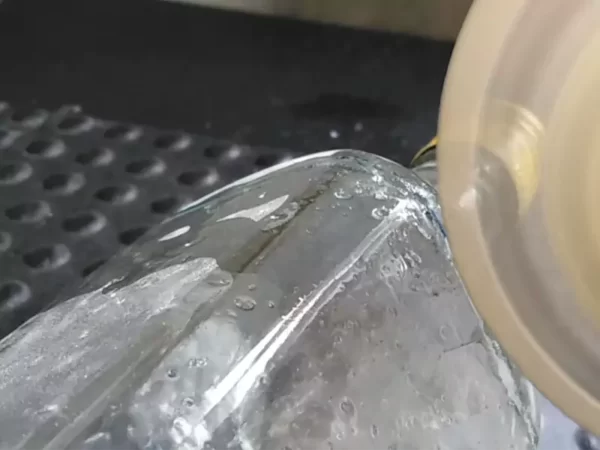Angle grinders are versatile tools perfect for cutting glass bottles with control and accuracy. New owners continue to wonder how to cut glass bottles with an angle grinder without entanglements, explosions, wheel breakage, or kickback issues.
With a lightweight and compact design, angle grinders can handle various home maintenance and DIY tasks. They are excellent tools ideal for cutting, grinding, polishing, sharpening, and removing excessive materials.
Using this versatile tool to cut glasses increases work efficiency, is time-saving, and improves productivity.

Here’s How to Cut Glass Bottles with Angle Grinder
Be prepared to swing into action with protective gears such as safety goggles and leather gloves to prevent eye, head, foot, or other impact injuries.
You’ll figure out how to mark bottles with tape, how to smooth the bottle edges, and prevent unnecessary accidents in this guide as well.
Step 1: Remove Labels on the Glass Bottle
Labels are an integral part of any bottle because it displays essential information about the brand. However, removing labels on glass bottles can be challenging as some are easier to peel off than others.
Using the water strategy for glass bottle labels is effective but not without flaws. You could have left-over glues, which is not ideal for the cutting project. The best way to remove labels without glue issues is by involving hot water and soaking for 10 minutes.
Labels become soft and easy to peel using this strategy. You can remove labels and left-over glues with a wire brush, brush, or a kitchen knife. If you still have some hard-to-remove sticky residue, bring a light fluid into the equation.
Rub the fluid or nail varnish remover to the remaining part and gently scrape it off before cutting with an angle grinder.
Step 2: Prepare the Bottle

After removing labels from the glass bottle, it’s time to identify the cutting point and design with tape. Perform adequate measurements on the bottle and determine the angle grinder point of contact.
It serves as your guide and ensures the circle remains clean after cuttings. Roll out the tape, draw the line at the center and wrap around the glass bottle for accuracy.
Place around the location you wish to start the cut. Using tape to line up two ends is more straightforward than using a marker to draw lines. It is not advisable to use an angle grinder on a glass bottle without marking it with tape.
When the grinding starts, the tape will keep the grinder in line, preventing it from slipping or falling off the mark. Angle grinders can be rough in the glass cutting process, but a suitable electrical or masking tape will enhance the process before cutting commences.
Step 3: The Cutting Process

Before cutting glass bottles with angle grinders, it is advisable to put on goggles, leather gloves, and an apron to prevent unexpected accidents.
You can also protect your gear from the machine’s sound with a set of earplugs. If you want a precise cut, place the bottle on a workbench or flat working surface and prepare the grinder.
Angle grinders offer an easy way to cut glass bottles. They usually rotate very fast, so be careful with the glass. If you want a successful cut and an accurate finish, glide the device through the glass bottle slowly.
Cut around the taped corner and avoid distractions. Most people hold the bottle with two hands while cutting and others prefer using hands. Although two hands provide stability when the grinder touches the bottle, using one hand is the best method as it is safer.
While holding the bottle, let it roll towards your position and not further away. Kickbacks are likely issues you’ll face while cutting a glass bottle with an angle grinder. In the event of a kickback, it will roll away from your body, keeping you safe.
Many people get nervous and fasten the cutting process, especially when the grinder touches the glass. It is advisable to resist increasing the cutting speed while in motion because it is dangerous and likely to cause accidents.
Cut through glass bottles slowly for accurate and optimal results. Cutting slowing is the safest method for glass cutting without breakage or kickback issues before you start sanding the edge for an even or smooth finish.
Nobody gets the first cut right. If you’re a newbie struggling to find your best cut, the machine’s wide flat face will enhance your accuracy. If you’re cutting a large wine bottle, don’t cut it round on a single line.
While you slowly cut through the glass, do not apply too much pressure because it can lead to bottle cracking.
In addition, keeping the bottle still and flat while cutting will ensure accuracy and increase your chance for success.
The bottle edge may not be as smooth as you desire, but your angle grinder machine will impress you with its unique glass cutting capabilities.
Troubleshoot For Glass Cutting
Glass cutters run into various problems using an angle grinder for the first time. Understanding how to troubleshoot common issues will enhance your productivity.
Unable to cut around curves
Watch your hands during the cutting process, and you could be tilting the glass cutter while going around curves. Please focus on the angle grinder and hold it upright during the cutting process.
If you want to make an ideal break, keep the cutting pressure constant, do not ease or increase the pressure around the curves.
Bad cuts
Bad cuts are common problems for beginners, and the best way to solve this problem is constant practice. Use a plain window glass for practice with the machine because it is easy to cut and affordable, unlike a glass bottle that requires special care.
After constant practice with plain glass with a comfortable feeling, consider cutting tempered glass with a grinder because it will shape your accuracy. Another solution to that problem is changing of angle grinder.
These machines come in different styles, and changing the tool may be the ideal solution if you continue to make bad cuts.
Glass continues to break
The most likely solution to this problem is to modify the pressure applied to the machine while cutting. If you’re pressing too hard, the glass will break, especially from an unexpected point.
But if you’re not applying adequate pressure, it will also cause breakage. There should be a static/zipper sound from the machine while cutting.
Keep the cutting speed at adequate pressure if you don’t want the glass to break.
FAQs
1. Can a grinder be used on glass?
Yes, grinders can handle glasses. While grinders are usually rough on glasses, using an electrical or masking tape as a guide will ensure optimal results.
Cutting with grinders requires protective gears, but the hand-held tool is ideal for grinding and cutting glasses accurately.
2. What kind of blade do you use to cut glass?
Glass mosaic and tiles are quality blades but with a high price on the market. If you focus on cutting glasses, consider investing in a professional diamond blade for its efficiency. You need to spend a fair amount of money on a quality glass cutter.
3. What is the easiest way to cut glass bottles?
The easiest way to cut a glass bottle is using a glass cutter or angle grinder. Remove labels from the bottle, use tape to mark the cutting point, and place on a workbench. Put on your protective gears and cut your glass slowly.
4. How much water do I put in my glass grinder?
Water plays an essential role for glass grinders, and it requires adequate filling. The proper water level for the machine is to the shoulder on the indicator in the well. Fill the water to the top of the shoulder for effective performance.
5. Can you grind glass with a bench grinder?
Yes, bench grinders can grind glasses of different types depending on their texture and fragility.
But use an exceptional grit wheel on the glass slowly to avoid shattering. Although bench grinders can grind glasses, diamond grinders are ideal tools for admirable results.
Cutting glasses with an angle grinder will save your time, effort and enhances productivity. This tool is affordable, convenient, lightweight, and ideal for cutting glasses like plexiglass, fiberglass, etc.
Recent Posts
Many DIY lovers and engineers want to build something cool in their garages. What's cooler than a kit airplane? In this setup, the builder receives parts and puts them together in their own space....
Diamond blades have various uses, from cutting tiles and glass to cutting gems and semiconductor materials. If you’re planning to start a renovation or building project, you’ll need a diamond...
